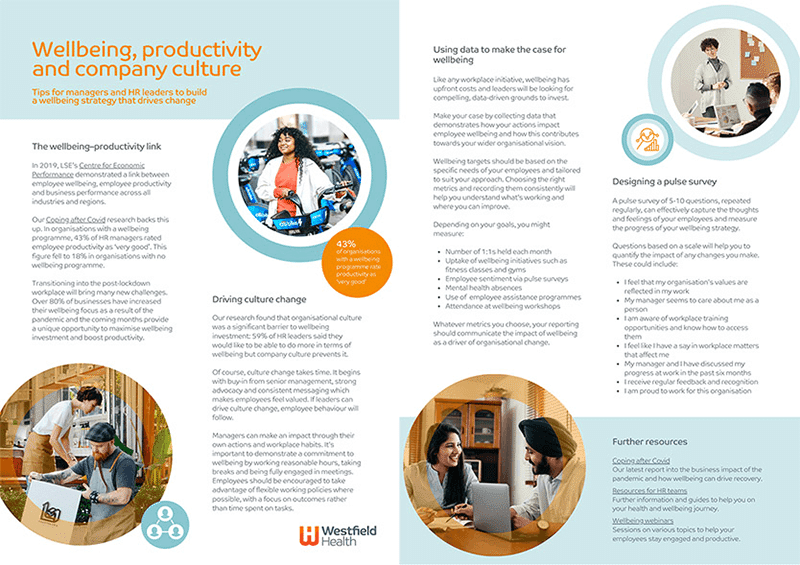In 2019, LSE’s Centre for Economic Performance demonstrated a link between company culture, employee wellbeing, employee productivity and business performance across all industries and regions.
Our Coping after Covid research backs this up. In organisations with a wellbeing programme, 43% of HR managers rated employee productivity as ‘very good’. This figure fell to 18% in organisations with no wellbeing programme.
Transitioning into the post-lockdown workplace will bring many new challenges. Over 80% of businesses have increased their wellbeing focus as a result of the pandemic, and the coming months provide a unique opportunity to maximise wellbeing investment and boost productivity. So how can HR leaders make a compelling, data-driven case for wellbeing investment?
Driving company culture change
Our research found that organisational culture was a significant barrier to wellbeing investment: 59% of HR leaders said they would like to be able to do more in terms of wellbeing but company culture prevents it.
Of course, culture change takes time. It begins with buy-in from senior management, strong advocacy and consistent messaging which makes employees feel valued. If leaders can drive culture change, employee behaviour will follow.
Managers can make an impact through their own actions and workplace habits. It’s important to demonstrate a commitment to wellbeing by working reasonable hours, taking breaks and being fully engaged in meetings. Employees should be encouraged to take advantage of flexible working policies where possible, with a focus on outcomes rather than time spent on tasks.
Using data to make the case for wellbeing
Like any workplace initiative, wellbeing has upfront costs and leaders will be looking for compelling, data-driven grounds to invest.
Make your case by collecting data that demonstrates how your actions impact employee wellbeing and how this contributes towards your wider organisational vision.
Wellbeing targets should be based on the specific needs of your employees and tailored to suit your approach. Choosing the right metrics and recording them consistently will help you understand what’s working and where you can improve.
Depending on your goals, you might measure:
- Number of 1:1s held each month
- Uptake of wellbeing initiatives such as fitness classes and gyms
- Employee sentiment via pulse surveys
- Mental health absences
- Use of employee assistance programmes
- Attendance at wellbeing workshops
Whatever metrics you choose, your reporting should communicate the impact of wellbeing as a driver of organisational change.
Designing a pulse survey
A pulse survey of 5-10 questions, repeated regularly, can effectively capture the thoughts and feelings of your employees and measure the progress of your wellbeing strategy.
Questions based on a scale will help you to quantify the impact of any changes you make. These could include:
- I feel that my organisation’s values are reflected in my work
- My manager seems to care about me as a person
- I am aware of workplace training opportunities and know how to access them
- I feel like I have a say in workplace matters that affect me
- My manager and I have discussed my progress at work in the past six months
- I receive regular feedback and recognition
- I am proud to work for this organisation
Choose a schedule for your pulse survey – perhaps once a month – and repeat the same questions to gain insight into any shift in employee sentiment.
Further reading and resources
Coping after CovidOur latest report into the business impact of the pandemic and how wellbeing can drive recovery.
Resources for HR teamsFurther information and guides to help you on your health and wellbeing journey.
Wellbeing webinarsSessions on various topics to help your employees stay engaged and productive.
